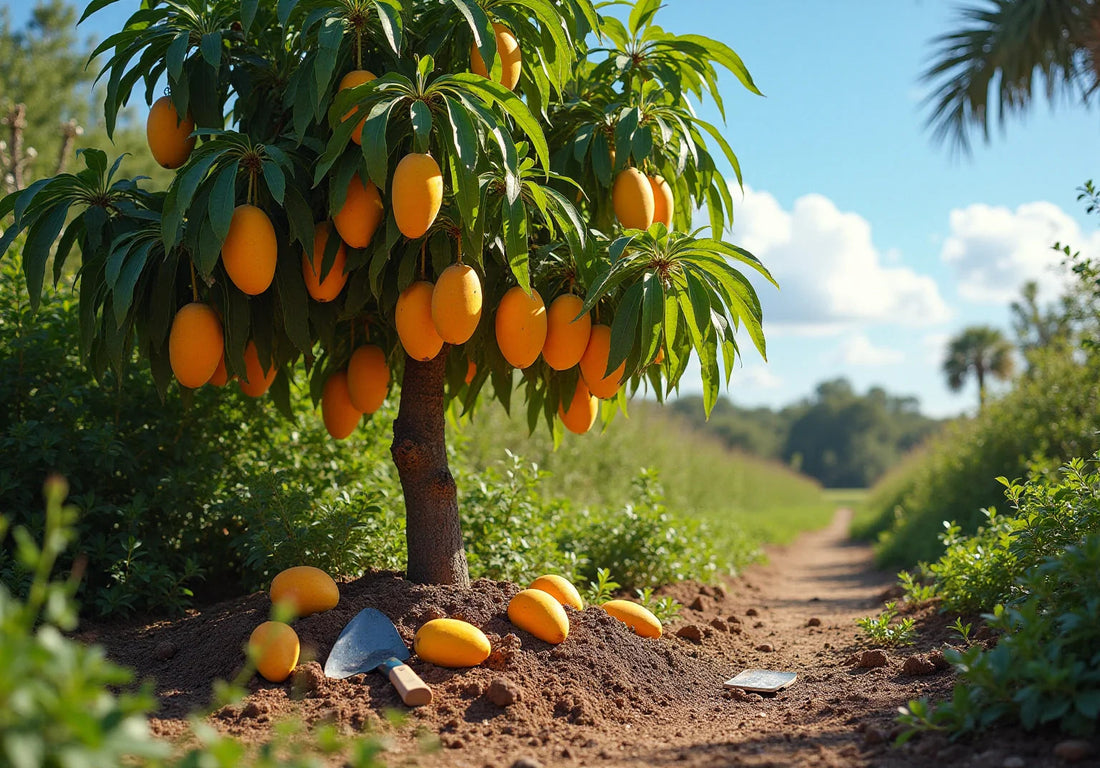
7 Sweetest Mango Varieties for Your Home Garden
Share
Mangoes, often referred to as the "king of fruits," not only delight the palate but also provide numerous benefits for home gardeners. With a diverse array of cultivars available, each offering distinct flavors and textures, growing these tropical treasures can transform any garden into a vibrant oasis. However, an important question arises: which mango varieties are the sweetest and most rewarding for home cultivation?
This article explores the top seven mango varieties that can enhance home gardens, offering gardeners both delectable fruit and a gratifying experience in nurturing their plants.
Everglades Farm: Premium Mango Trees for Home Gardens
Everglades Farm is renowned for its high-quality variety of fruit plants, specifically tailored for residential gardens. With a strong emphasis on quality and sustainability, the farm offers a diverse range of mango cultivars, featuring the sweetest mango, that thrive in Florida's warm climate. Each tree is meticulously grafted to promote optimal growth and fruit production, allowing home gardeners to savor the sweet rewards of their efforts.
Customers can select from popular varieties, including:
- 'Nam Doc Mai,' celebrated for its juicy sweetness and nutritional benefits
- 'Kesar,' known for its aromatic flavor
- 'Glenn,' which features a rich, tropical taste and is the sweetest mango
These selections not only enhance the aesthetic appeal of gardens but also contribute to a fruitful harvest, making them ideal for gardening enthusiasts eager to cultivate their own tropical paradise. Mangoes are typically in season from May through July, presenting an excellent opportunity for gardeners to plan their planting schedules.
Additionally, endorsements from satisfied clients highlight the exceptional quality and packaging of the plants, reinforcing Everglades Farm's reputation as a reliable provider of tropical produce. For instance, one customer praised the careful packaging that ensured their coconut cream grafted fruit arrived in perfect condition, contrasting it with a less favorable experience from another retailer.
As Michael Bassey Johnson wisely stated, 'If you wait for the fruit to fall, you’d be wasting your time while others are learning how to climb the tree.' This quote serves as a reminder for gardeners to take proactive steps in their gardening journey.
Rich in Nutrients: Health Benefits of Mangoes
Mangoes are not only a tropical delight but also a powerhouse of essential nutrients. Each cup of raw fruit provides approximately 100 calories, along with:
- 3 grams of dietary fiber
- 277 mg of potassium
- 70 µg of folate
- 60 mg of vitamin C
- 90 µg of vitamin A
These nutrients play a crucial role in promoting digestive health, boosting immune function, and enhancing skin vitality.
Recent studies indicate that regular consumption of mangoes is linked to lower intakes of added sugars, sodium, and cholesterol. Individuals who consume mangoes have significantly lower intakes of sodium and total fat compared to those who do not. Additionally, these fruits are associated with enhanced nutrient consumption, particularly among children and elderly individuals, who frequently do not meet dietary guidelines. For example, the consumption of mangoes in children is linked to a greater intake of:
- Dietary fiber
- Magnesium
- Potassium
- Total choline
- Vitamins B6, C, and D
Including mangoes in your diet may assist in reducing the risk of chronic diseases. Notably, around 80% of the US population over the age of one falls short of recommendations for fruit intake, making mangoes an invaluable addition to a balanced and nutritious lifestyle.
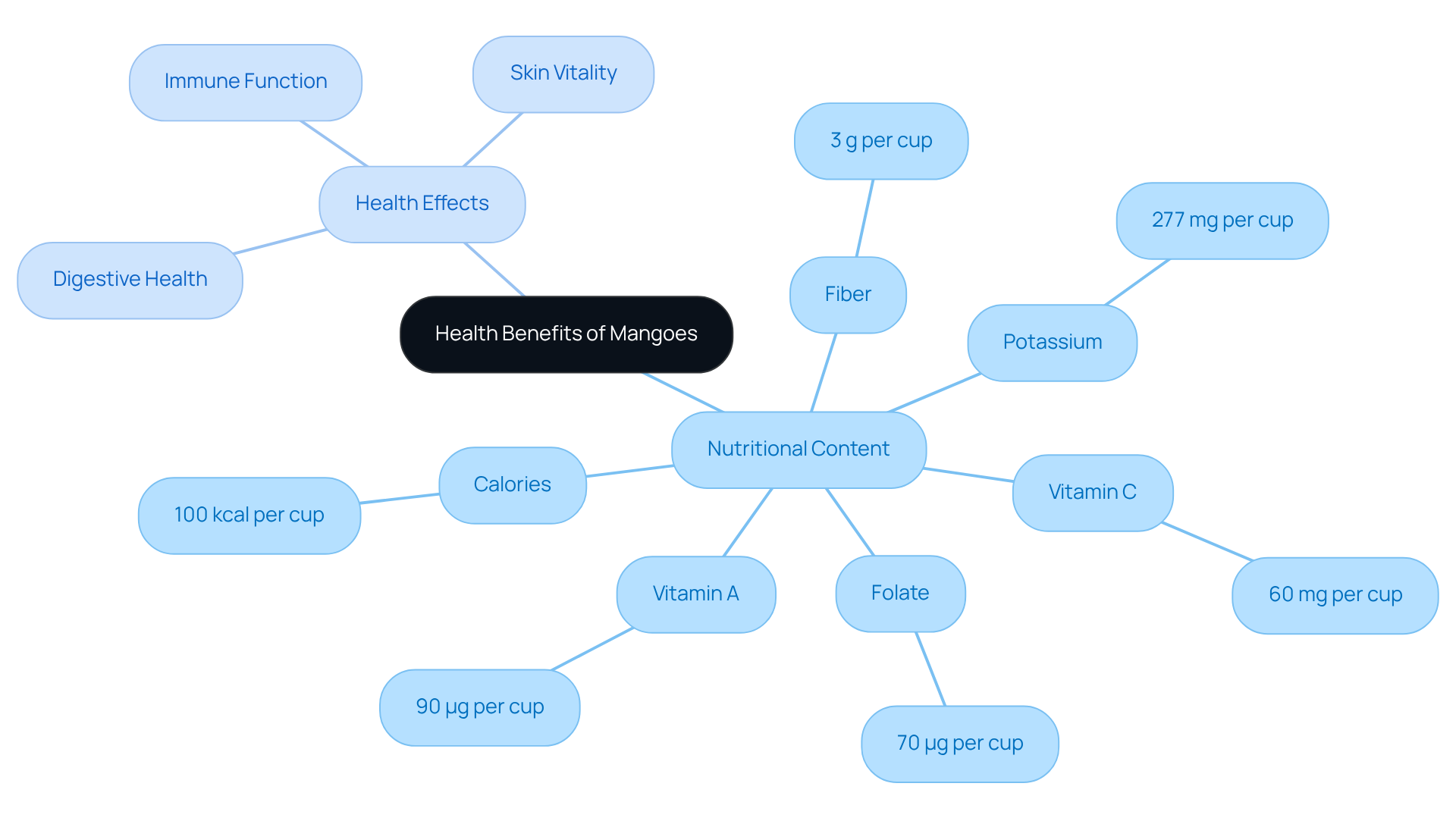
Diverse Varieties: Exploring Popular Mango Types
Mangoes come in an abundance of types, each boasting its own unique flavor profile and texture. Here are some of the most sought-after types:
- Alphonso: Often hailed as the king of mangoes, this Indian variety is celebrated for its rich sweetness and smooth texture, making it a favorite among mango enthusiasts.
- Kesar: Another gem from India, Kesar varieties offer the sweetest mango flavor, complemented by a hint of tanginess, perfect for enhancing desserts and smoothies.
- Nam Doc Mai: This Thai type is prized for its floral aroma and is known as the sweetest mango because of its sweet, juicy flesh, making it an ideal choice for fresh eating and tropical salads.
- Haden: A favored selection in the U.S., Haden fruits are recognized for their vivid hue and are often regarded as the sweetest mango, frequently savored fresh or in salsas.
- Tommy Atkins: Recognized for its firm, fibrous flesh and long shelf life, this variety is widely marketed and offers a more tart flavor, appealing to those who enjoy a bit of zest in their fruit.
- Ataulfo: Small and yellow, Ataulfo varieties are known for being the sweetest mango, creamy and sweet with a non-fibrous texture, making them a delightful treat for those who prefer a smooth bite.
- Kent: With its yellow skin and red blush, Kent varieties are known for being the sweetest mango, with a sweet flavor and near fiberless flesh, making them a popular choice for juicing and fresh consumption.
As Kristyn Leach, a committed farmer and seed saver, stresses, 'If you control seeds, you control food,' underscoring the significance of choosing the appropriate types for home gardens. In fact, India grows more than 1,000 distinct types of fruit, showcasing the remarkable diversity available. Successful cultivation of these fruit varieties can lead to bountiful harvests, allowing gardeners to enjoy the sweet rewards of their efforts. In the U.S., consumer preferences favor types such as Alphonso and Ataulfo, which are appreciated for their remarkable sweetness and texture, especially the sweetest mango, making them perfect for home gardening enthusiasts wanting to bring a taste of the tropics to their backyards. Significantly, more than 75% of the fruits carried by Air India came from Western India, highlighting the appeal of these types.

Culinary Delight: Mangoes in Recipes and Beverages
Mangoes, particularly the sweetest mango, are incredibly versatile fruits that can elevate a variety of dishes and beverages. Here are some delightful ways to incorporate mangoes into your meals:
- Mango Salsa: Combine diced mango with red onion, cilantro, lime juice, and jalapeño for a refreshing salsa that pairs beautifully with grilled meats or fish. As noted by Anthony William, "Speaking of the fruit, one delicious alternative meal is fruit salsa, which showcases the sweetest mango's vibrant flavor."
- Smoothie: Blend ripe mango with yogurt, banana, and a splash of orange juice for a nutritious breakfast that delivers a flavorful punch.
- Chutney: Cook the sweetest mango with spices, vinegar, and sugar to create a sweet and tangy condiment that complements meats and enhances sandwiches.
- Fruit Sorbet: Puree the sweetest mango with sugar and freeze it for a refreshing dessert that’s perfect for hot summer days.
- Coconut Chia Pudding with Fruit: Combine chia seeds with coconut milk and chopped tropical fruit for a nutritious dessert or breakfast choice that is both satisfying and delicious.
- Tropical BBQ Sauce: Puree the sweetest mango with tomato paste, vinegar, and spices to create a unique BBQ sauce that adds a tropical twist to your grilling.
- Upside-Down Cake with the Sweetest Mango: Arrange sliced tropical stone fruits, including the sweetest mango, in a cake pan, pour a brown sugar mixture on top, and bake for a delightful dessert that showcases the natural sweetness.
As consumption of mangoes in the U.S. continues to rise, with 26% of consumers purchasing them in the past year, the demand for innovative products and recipes based on this fruit is also expanding. The per capita retail availability of fresh tropical produce has notably increased, from 2.1 pounds in 2010 to 3.5 pounds in 2021, suggesting a growing interest in this delicacy. Food bloggers are increasingly sharing innovative applications for mango, inspiring home cooks to explore it in new and exciting ways.

Gardening Appeal: Growing Mangoes at Home
Cultivating this tropical fruit at home can be a rewarding endeavor, offering not just delicious produce but also the joy of nurturing plants. Here are essential tips for successful cultivation:
- Choose the Right Variety: Selecting a mango variety that aligns with your climate and available space is vital. Varieties such as Cabeza, Maha Chanok, and Golden Nugget are celebrated for being the sweetest mangoes and their adaptability.
- Best Planting Location: Mango plants thrive in full sun and well-draining soil. Aim for a planting distance of 10m x 10m in dry zones and 12m x 12m in moist zones to facilitate optimal growth. Ensure the location is shielded from strong winds, which can damage young plants.
- Watering Techniques: Young mango plants need consistent watering to establish roots, but be cautious to avoid overwatering. Mature plants exhibit greater drought resistance and require less frequent irrigation, especially during the wet season.
- Fertilization: To encourage robust growth and fruiting, apply a balanced fertilizer during the growing season. This practice enhances the plant's vitality and boosts yield, which can average between 5 to 9 tonnes per acre.
- Success Stories: Numerous home gardeners have successfully cultivated mangoes across various climates, sharing their experiences of joy and fulfillment. For instance, one gardener noted that patience and consistent care led to a bountiful yield after several years of nurturing their plants. Another gardener reflected on the wisdom of planting greenery for future generations, resonating with the sentiment of a Greek proverb.
- Cultivation Methods: Successful cultivation of this fruit necessitates an understanding of the plant's needs, including appropriate spacing, irrigation, and pest control. Regular pruning can also support plant health and improve fruit quality. As one gardener articulated, 'The joy of seeing my fruit tree flourish has been a transformative experience, reminding me that gardening is a continuous journey of learning and growth.'
By adhering to these guidelines, you can cultivate a thriving garden that enhances your outdoor space while providing a delightful harvest for years to come.
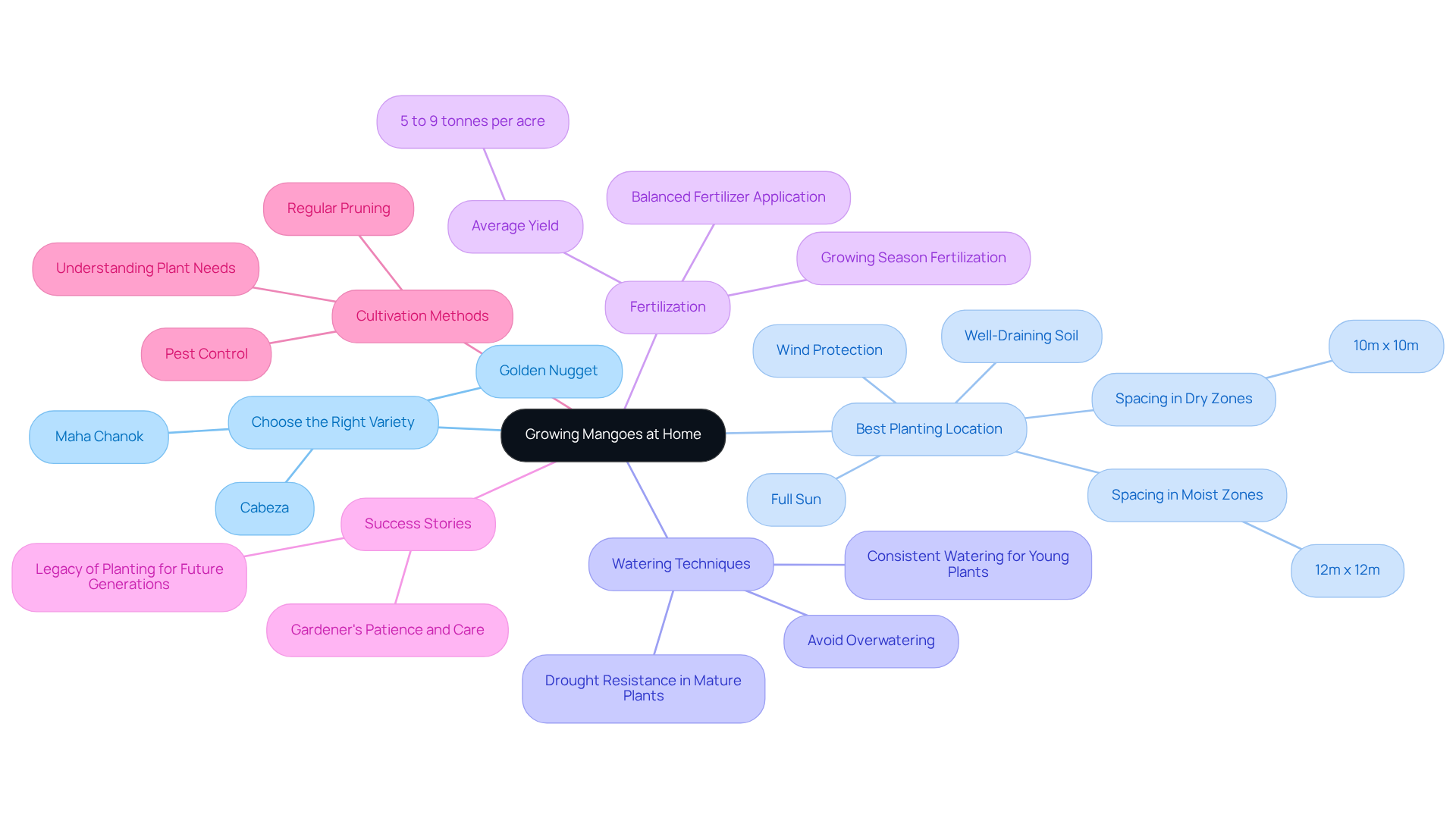
Flavor Explosion: The Unique Taste of Mangoes
Mangoes, often celebrated as the 'king of fruits,' are distinguished by their remarkable flavors, with the sweetest mango exhibiting significant variation among different varieties. The Alphonso variety is particularly esteemed for its rich, buttery sweetness, which makes it the sweetest mango and earns it a special place among fruit connoisseurs. In contrast, Kesar mangoes provide the sweetest mango experience with a delightful balance of sweetness and acidity, offering a refreshing twist that appeals to diverse palates.
The taste characteristics of mangoes are as diverse as their origins, with over 1,000 types available worldwide. For example, the Ataulfo variety from Mexico is known for its creamy texture and honey-like sweetness, while the Kent variety is often considered the sweetest mango, boasting juicy, fibrous flesh that harmonizes sweetness with a subtle tartness. Each variety presents its own unique flavor experience, contributing to the fruit's reputation as a culinary treasure.
Experts agree that mangoes' versatility in the kitchen enhances their appeal even further. Whether enjoyed fresh, blended into smoothies, or incorporated into savory dishes, this fruit adds a burst of flavor that elevates any meal. This remarkable diversity in flavor and texture is what makes mangoes cherished across cultures, solidifying their status as the ultimate exotic delicacy.
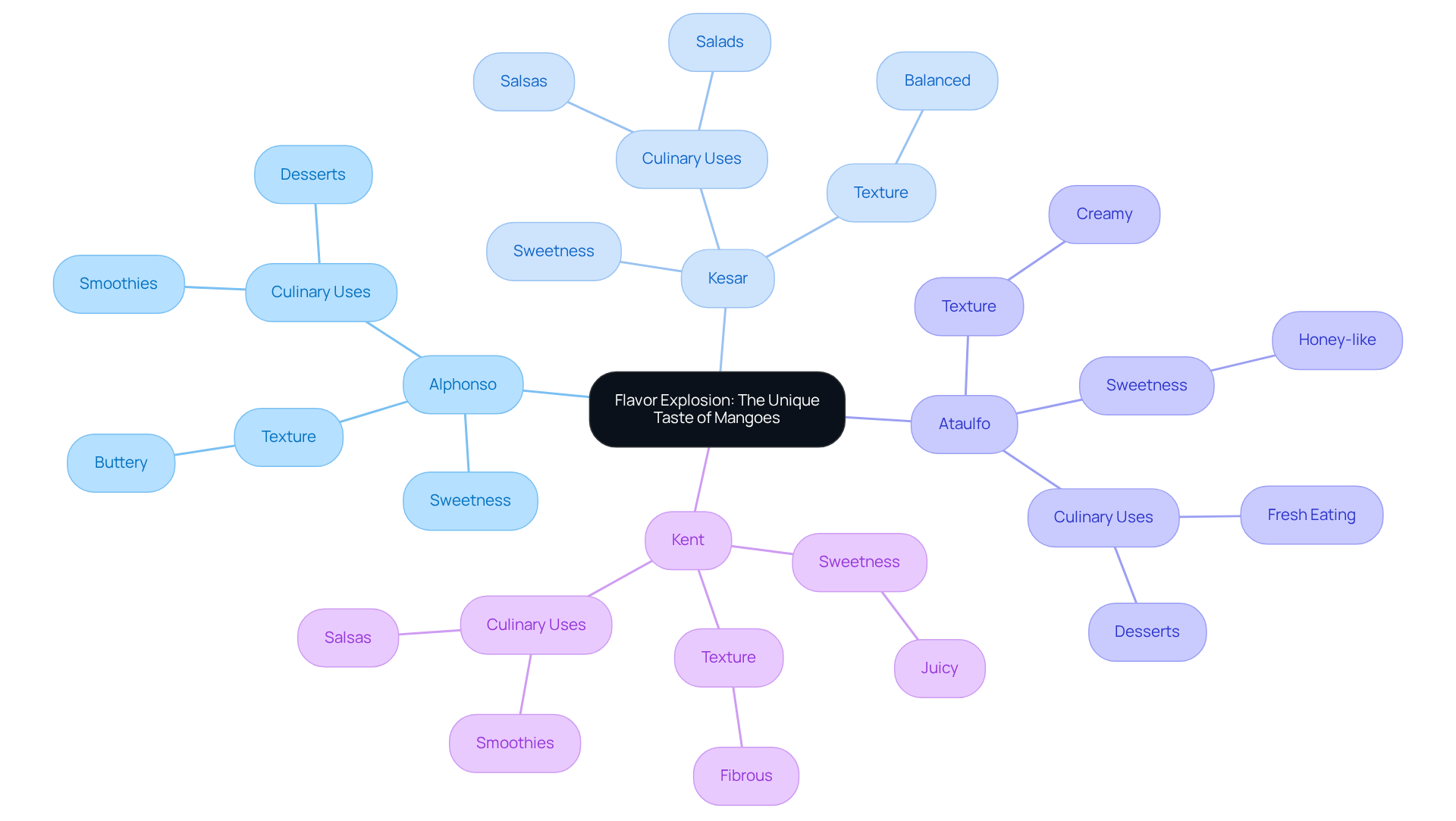
Cultural Significance: Mangoes in Traditions and Celebrations
Mangoes hold a significant place in various cultures worldwide. In India, for instance, they are often linked to love and prosperity, symbolizing good fortune during weddings and festivals. As Abhay Desai notes, this tropical delicacy transcends mere produce; it embodies love, prosperity, and good fortune. Additionally, mango leaves are utilized in decorations and rituals, representing new beginnings. In numerous tropical nations, festivals celebrate the abundance of this crop, showcasing diverse varieties and culinary delights.
The annual 'Aam Mahotsav' in India, for example, attracts thousands of attendees, underscoring the fruit's importance in local economies and traditions. In Guatemala, the consumption of mangoes ranges from 13 million to 15 million fruits annually, accounting for 25% of exports, which highlights the economic impact of these fruits on local communities. Furthermore, National Mango Day, celebrated on July 22, serves as a special tribute to this beloved delicacy. This cultural significance enhances the allure of mangoes, elevating them beyond a mere tasty treat; they symbolize happiness, togetherness, and cultural heritage.
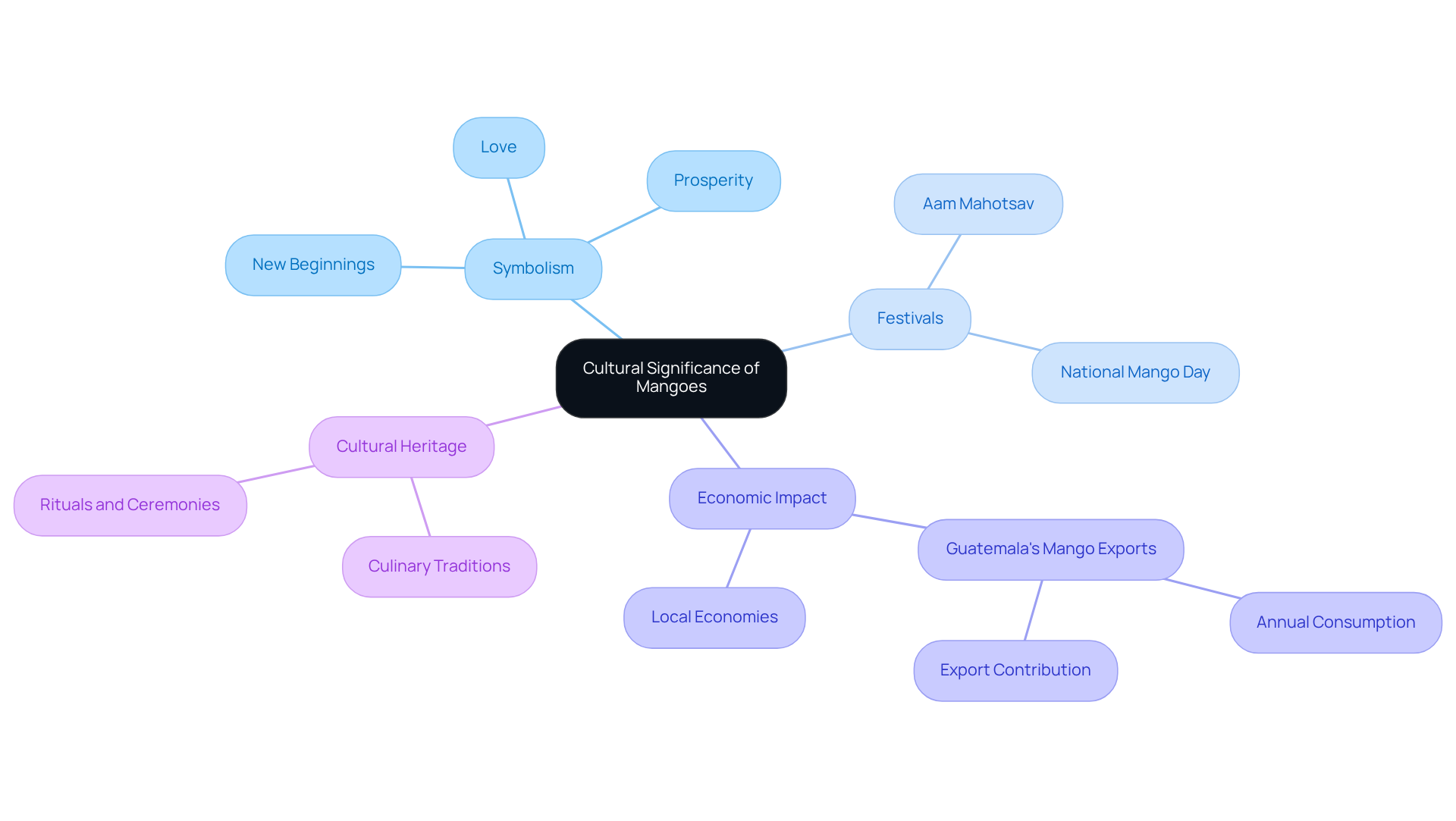
Sustainable Gardening: Environmental Benefits of Mango Trees
Mango plants are essential to sustainable gardening, providing numerous environmental benefits. They significantly improve air quality by absorbing carbon dioxide and releasing oxygen, which is crucial for a healthy ecosystem. Additionally, the canopy created by fruit-bearing plants reduces urban heat, leading to lower energy costs during warmer months—these plants can decrease energy use by nearly 12% in residential areas. Their strong root systems not only prevent soil erosion but also enhance soil health, creating a thriving environment for other plants. Furthermore, mango plants are drought-resistant and adaptable to varying climates, making them suitable for diverse cultivation scenarios.
By incorporating fruit-bearing plants into their gardens, enthusiasts can promote biodiversity and contribute to a more sustainable ecosystem right in their backyards. As noted by sustainability experts such as Jules Pretty and Vandana Shiva, cultivating mango plants aligns with the principles of regenerative agriculture, which aims to restore and maintain the health of our planet's ecosystems. However, it is also important to consider potential drawbacks, such as attracting wildlife or causing allergic reactions, to ensure a balanced approach to urban gardening.
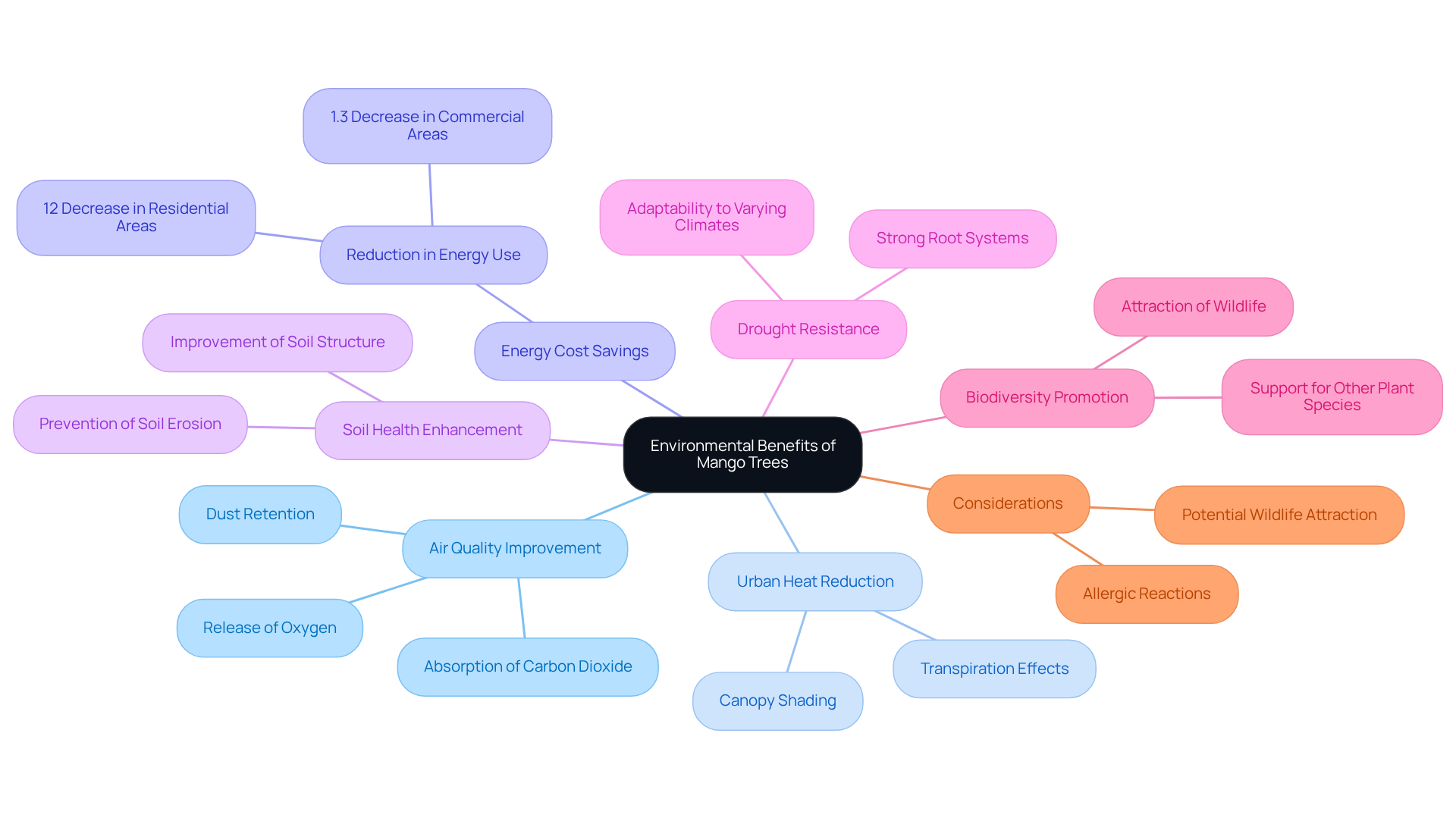
Low Maintenance: Caring for Mango Trees
Mango plants require relatively low maintenance once established; however, proper care is essential for optimal health and fruit production. Below are some key care tips:
- Pruning: Regular pruning is crucial for maintaining the tree's shape and removing any dead or diseased branches. This practice not only promotes healthy growth but also improves air circulation, thereby reducing the risk of disease.
- Pest Management: Vigilance against common pests such as aphids and scale is important. Implementing organic pest control methods, such as introducing beneficial insects or using neem oil, can effectively safeguard your plant while minimizing chemical use. Additionally, for those cultivating passion fruit alongside other fruit plants, managing passion vine hoppers through organic techniques can be advantageous.
- Watering: Allow the soil to dry out between waterings to prevent root rot, a common issue in mango cultivation. Mature plants generally require less frequent irrigation, making them more resilient against drought conditions. Research indicates that moderate regular deficit irrigation can enhance crop water productivity, benefiting overall tree health.
- Fertilization: During the growing season, applying a balanced fertilizer supports healthy growth and crop production. Targeted nutrient applications can improve yield and produce quality.
By adhering to these care tips, you can ensure that your trees flourish, allowing you to enjoy the sweetest mango and other delicious produce for years to come.
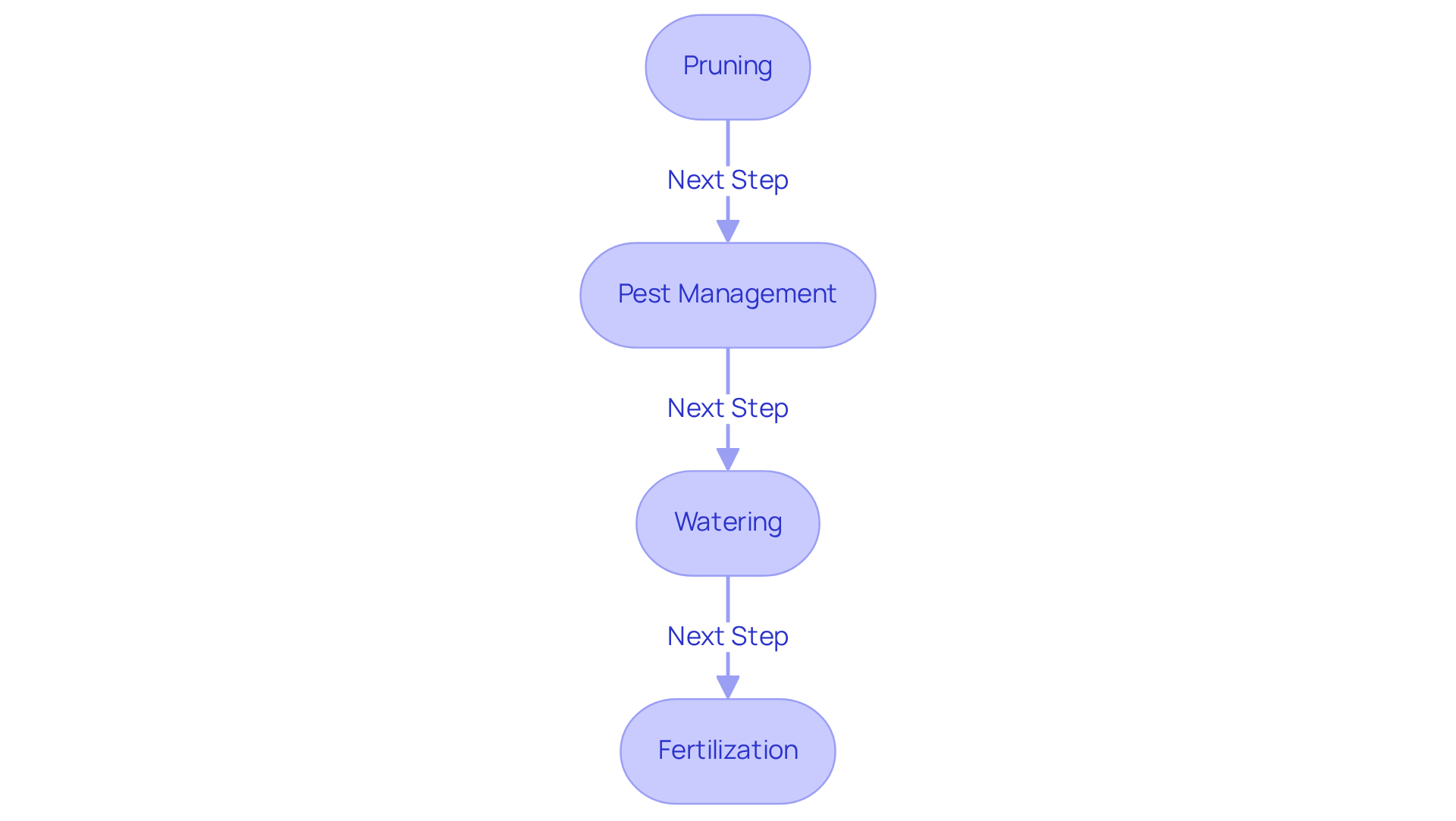
Harvest Joy: The Satisfaction of Picking Fresh Mangoes
There is nothing quite like the joy of harvesting fresh fruits from your own garden, particularly varieties such as the Coconut Cream and Maha Chanok. As the fruit matures, excitement builds, culminating in the rewarding moment of harvesting a perfectly ripe fruit. This experience transcends merely savoring the sweet, juicy taste; it embodies the fulfillment of nurturing a plant from a small seedling into a bountiful bearer.
Home gardeners frequently share their delight in harvesting, noting how the process enhances their outdoor spaces and positively impacts their mental well-being. Gardening, especially with fruit trees, fosters a profound sense of accomplishment and joy, making it a cherished activity for those cultivating their own tropical paradise.
One gardener remarked, 'There’s nothing like the sensation of harvesting a fruit that you’ve nurtured from a tiny seedling. It’s a moment of pure joy!'
Another customer praised Everglades Farm, stating, 'I ordered a coconut cream grafted fruit, and it arrived in perfect condition, thanks to the thoughtful packaging.'
With Everglades Farm's commitment to quality, you can be assured of obtaining healthy mango plants, further enhancing the enjoyment of homegrown produce.
Frequently Asked Questions
What is Everglades Farm known for?
Everglades Farm is renowned for its high-quality variety of fruit plants, particularly mango trees tailored for residential gardens, emphasizing quality and sustainability.
What mango varieties does Everglades Farm offer?
Everglades Farm offers several popular mango varieties, including 'Nam Doc Mai' (known for its juicy sweetness), 'Kesar' (known for its aromatic flavor), and 'Glenn' (the sweetest mango).
When is the mango season, and why is it important for gardeners?
Mangoes are typically in season from May through July, which presents an excellent opportunity for gardeners to plan their planting schedules for optimal fruit production.
What do customers say about the quality of plants from Everglades Farm?
Customers have praised the exceptional quality and careful packaging of the plants, highlighting their satisfaction with the condition in which their grafted fruit arrives.
What are the health benefits of consuming mangoes?
Mangoes are rich in essential nutrients, providing dietary fiber, potassium, folate, vitamin C, and vitamin A, which promote digestive health, boost immune function, and enhance skin vitality.
How do mangoes impact dietary habits?
Regular consumption of mangoes is linked to lower intakes of added sugars, sodium, and cholesterol, and can enhance nutrient consumption, particularly among children and the elderly.
What are some popular types of mangoes and their characteristics?
Popular mango varieties include: - Alphonso: Rich sweetness and smooth texture. - Kesar: Sweet flavor with a hint of tanginess. - Nam Doc Mai: Floral aroma and juicy flesh. - Haden: Vivid hue and sweet flavor. - Tommy Atkins: Firm, fibrous flesh with a tart flavor. - Ataulfo: Small, yellow, creamy, and sweet. - Kent: Sweet flavor with near fiberless flesh.
Why is it significant to choose the right mango varieties for home gardens?
Selecting appropriate mango types for home gardens can lead to successful cultivation and bountiful harvests, allowing gardeners to enjoy the sweet rewards of their efforts.

